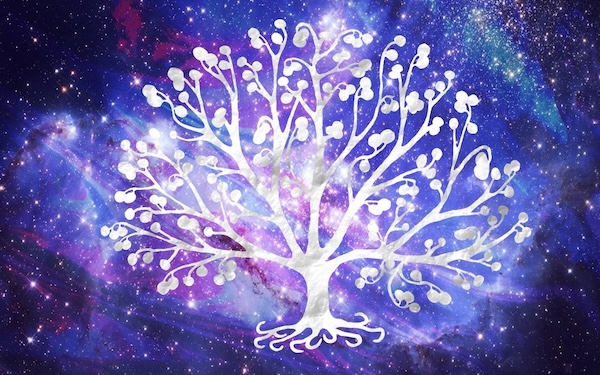The Tree of Life stands as one of humanity’s most enduring and universal spiritual symbols, appearing across cultures and traditions throughout history. This powerful image of a tree, often encircled by a ring or sphere, represents the interconnection of all life and the unity of existence itself. Unlike the more abstract Kabbalistic Tree of Life, this natural symbol draws its power from the inherent symbolism of the tree as a bridge between earth and sky, matter and spirit.
Historical Origins and Cultural Presence
The Tree of Life symbol appears in remarkably similar forms across ancient civilizations, suggesting a deep human recognition of its spiritual significance. Ancient Mesopotamian art features the sacred tree prominently, often depicting it with divine figures or mystical creatures. The Norse tradition speaks of Yggdrasil, the world tree that connects the nine worlds. In ancient Egypt, the Acacia tree held sacred significance, representing the tree where life and death were reunited.
Celtic culture particularly revered the Tree of Life, viewing it as a symbol of the connection between the three realms of existence: the underworld (roots), the earth (trunk), and the heavens (branches). The circle often surrounding the Celtic Tree of Life represents the eternal cycle of life and the interconnected nature of all existence.
Symbolic Elements and Their Meanings
The Tree of Life symbol contains several key elements, each carrying profound spiritual significance:
The Roots
The roots reaching deep into the earth represent our connection to the physical world and our ancestral heritage. They symbolize grounding, stability, and nourishment from the earth. In many traditions, the roots also represent the subconscious mind and the hidden realms of existence that support visible life.
The Trunk
The trunk symbolizes the physical realm of existence and our journey through life. It represents strength, stability, and growth. The trunk serves as the connector between earth and sky, matter and spirit, demonstrating how spiritual growth requires both grounding and aspiration.
The Branches
Reaching toward the heavens, the branches represent spiritual aspiration and growth. They symbolize the diverse ways in which life expresses itself and our connection to higher realms of consciousness. The branching pattern also suggests the interconnected nature of all things and the multiplication of life’s possibilities.
The Circle
When present, the surrounding circle represents wholeness, unity, and the cyclical nature of existence. It suggests protection, containment, and the boundary between manifest form and infinite possibility. The circle also symbolizes eternity and the continuous cycle of birth, death, and rebirth.
Spiritual Significance Across Traditions
While interpreted differently across cultures, several common themes emerge in the spiritual significance of the Tree of Life:
Unity and Interconnection
The Tree of Life powerfully represents the fundamental interconnection of all existence. Its branches, leaves, and roots form a complex network that mirrors the web of life itself. This symbolism reminds us that no being exists in isolation, but rather as part of a vast, living system.
Growth and Transformation
The tree’s natural growth patterns represent spiritual and personal development. Just as a tree grows from seed to maturity through various stages, human consciousness evolves through different levels of awareness and understanding.
Balance and Harmony
The tree demonstrates perfect balance between opposing forces: earth and sky, matter and spirit, darkness and light. This balance teaches the importance of integrating different aspects of existence rather than rejecting or favoring one over another.
Cycles of Life
Through its seasonal changes, the tree represents the natural cycles of birth, death, and renewal. This symbolism helps us understand and accept the cyclic nature of all existence and the continuous process of transformation.

Practical Applications and Modern Relevance
The Tree of Life symbol continues to offer profound wisdom for contemporary spiritual seekers:
Meditation and Contemplation
The symbol serves as a powerful focus for meditation, helping practitioners:
- Ground their energy through connection with the roots
- Center themselves through alignment with the trunk
- Expand consciousness through connection with the branches
- Experience unity through contemplation of the whole
Personal Growth Work
The symbol provides a framework for understanding personal development:
- Roots represent our foundation and resources
- Trunk symbolizes our current life journey
- Branches represent our aspirations and potential
- The surrounding circle suggests our connection to the whole
Environmental Awareness
The Tree of Life symbol speaks powerfully to modern environmental concerns, reminding us of:
- The interconnected nature of ecosystems
- The importance of maintaining balance in nature
- Our responsibility as stewards of the earth
- The sacred nature of life itself
Contemporary Interpretations
Modern understanding of the Tree of Life has expanded to include new dimensions:
Scientific Parallels
The branching pattern of the tree mirrors many natural phenomena:
- Neural networks in the brain
- Evolutionary development of species
- River systems and watershed patterns
- Fractal patterns in nature
Psychological Significance
Contemporary psychology finds meaning in the symbol:
- Individual growth and development
- Family relationships and genealogy
- Personal integration and wholeness
- Connection between conscious and unconscious
Working with the Symbol
For those drawn to work with the Tree of Life symbol, several approaches prove beneficial:
Creative Expression
Engaging with the symbol through:
- Drawing or painting
- Sculpture or crafts
- Dance or movement
- Meditation visualization
Sacred Space Creation
Using the symbol to enhance spaces:
- As a focal point for meditation areas
- In garden design
- For altar decoration
- In environmental art
Conclusion
The Tree of Life symbol continues to offer profound wisdom for contemporary life. Its representation of unity, growth, and interconnection speaks directly to many modern concerns and aspirations. Whether approached through traditional spiritual practice, environmental awareness, or personal growth work, this ancient symbol provides a powerful tool for understanding our place in the cosmos and our relationship with all of existence.
As humanity faces increasing challenges regarding environmental sustainability and spiritual meaning, the Tree of Life reminds us of essential truths about our relationship with nature and our own spiritual growth. Its enduring presence across cultures and times suggests its continued relevance for future generations seeking wisdom and connection.

